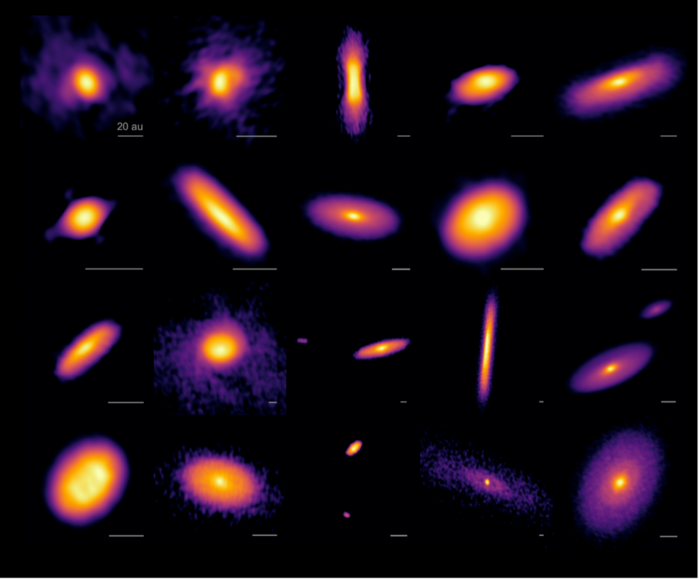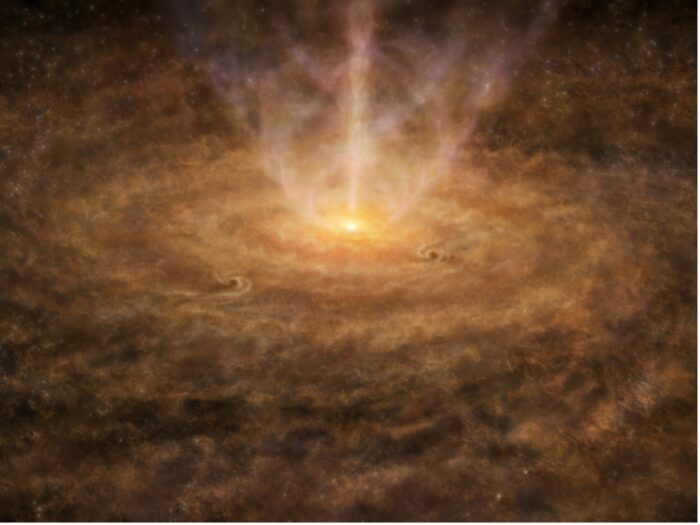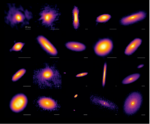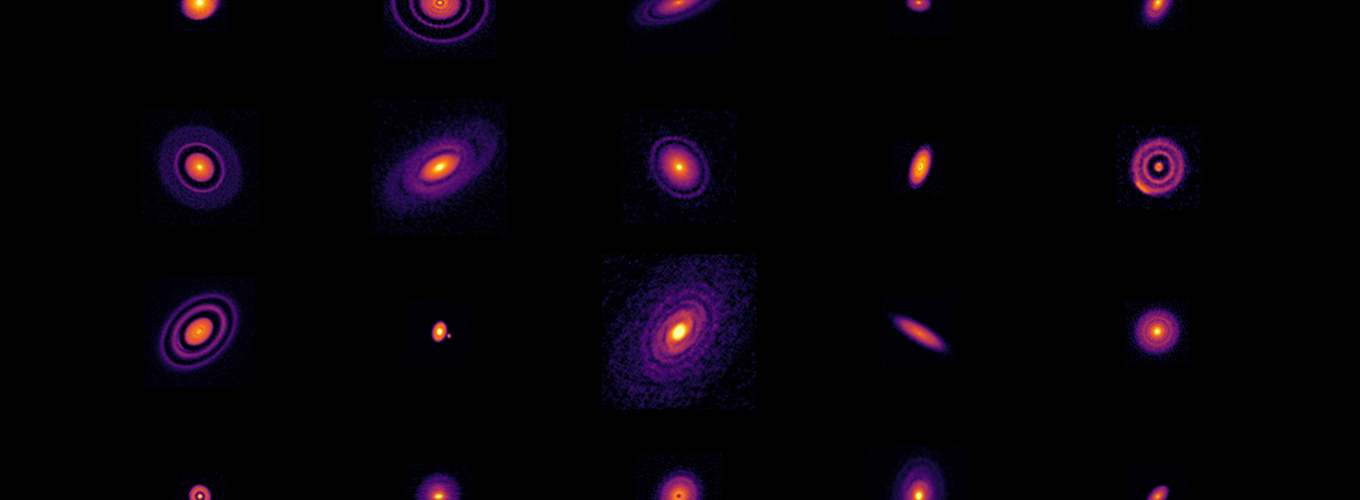ALMA Digs Deeper into the Mystery of Planet Formation
An international research team used the Atacama Large Millimeter/submillimeter Array (ALMA) to observe disks around 19 protostars with a very high resolution to search for the earliest signs of planet formation. This survey, called "Early Planet Formation in Embedded Disks (eDisk)" and led by Nagayoshi Ohashi at Academia Sinica Institute of Astronomy and Astrophysics (ASIAA, Taiwan), was motivated by the recent findings that planet formation may be well-underway in the more-evolved protoplanetary disks that have been studied in detail with ALMA, but until now there had been no systematic study to search for signs of planet formation in younger protostellar systems.
The origins of our Solar System and extrasolar planetary systems is one of the most important themes in modern astronomy. Our Sun formed about 4.6 billion years ago and all Sun-like stars form through a similar process. As part of this process, a disk forms around the newborn star and within these disks planets will form.[1] These protoplanetary disks are expected to only last a few million years, meaning that a forming planetary system only has this amount of time to finish its formation. However, it is still not clear just how rapidly planet formation begins within their disks. Recent ALMA observations have revealed that many protoplanetary disks have substructures such as gaps and rings. This is strong evidence that planets are forming and sweeping up material from the disk. On the other hand, many proto-planetary disks show such signs, suggesting that planet formation is already in progress or has almost completed in the systems we typically refer to as 'protoplanetary disks'. “These previous results motivated us to examine even younger disks around protostars to answer the question, at what stage of star formation do planet forms,” says Ohashi.
With this motivation, the team focused on disks around protostars, systems that are only 10,000 to 100,000 years old, and observed the radio emission emitted from dust grains, i.e., the building blocks of planets, in disks with ALMA. Previous studies have only observed a small handful of protostars with the resolution necessary to detect signs of planet formation. The international team observed disks around 19 protostars located within about 650 light-years from the Earth utilizing the very high angular resolution of ALMA[2] to examine the structure of the protostellar disks in detail. This is the first systematic study to investigate the detailed structure of disks around a large sample of protostars with such a high angular resolution.
The observations confirmed that there are disks around all the protostars, meaning that the minimum conditions for planet formation are already present in these young protostar systems. However, the observations clearly show that the disks around protostars are different from more-evolved protoplanetary disks. Among the 19 protostars, rings, and gaps, which are signs of planet formation, were observed only in a few disks toward the most evolved protostars. Moreover, the ring structures are less distinct than those seen in the protoplanetary disks. It was also found that the dust (building blocks of planets) in many disks, is not settled in the disk midplane. Rather the dust is aloft, above the disk midplane, making the disks appear thick in the vertical direction. In more-evolved disks, in contrast, the dust settles down in the midplane thereby making them appear much thinner. “We did not expect to see such clear differences between disks around protostars and more-evolved disks,” says Ohashi. John Tobin, a Co-PI of the program at the National Radio Astronomical Observatory (USA) adds “Our results suggest that disks around protostars are not fully ready for planet formation. We believe that the actual formation of the planetary system progresses rapidly in the 100,000 years to 1,000,000 years after star formation begins”.
Jes Jørgensen, the other Co-PI of the program at the Niels Bohr Institute of University of Copenhagen (Denmark) also mentions the importance of international cooperation in planning and implementing such a large-scale program. “There are 37 researchers from 15 research institutes participating in the international research group that promoted this research. In addition, about half of them are graduate students or young researchers who have recently obtained their Ph.D. This research gives many young researchers the opportunity to participate in large-scale international programs, and it can be said that this program plays a major role in nurturing future research and collaboration.”
Notes
- In the 1960s, a research group led by Prof. Chushiro Hayashi at Kyoto University, Japan constructed a model of planetary system formation called the "Hayashi Model." In that model, it was assumed that planet formation progressed in the disk around a newborn star about 1-10 million years after the formation of the protostar. At that time, it was not observationally confirmed that disks actually existed around newborn stars, and only later did observations directly detect protoplanetary disks around young stars.
- The resolution of the eDisk ALMA observations was as good as 0.04 arcseconds – similar to the size of a coin seen at a distance of 100 km.
Additional Information
Initial results of the research are detailed in a series of 18 articles. Five of them, including Ohashi et al. presenting the overview of the program, were accepted in the Astrophysical Journal, and the first 4 are published on June 27, 2023 in the Astrophysical Journal. Preprints of the 5 articles are also appeared in arXiv on June 27, 2023. In addition, more articles based on further detailed analysis are in preparation.
Nagayoshi Ohashi et al. “Early Planet Formation in Embedded Disks (eDisk). I. Overview of the Program and First Results”
Zhe-Yu Daniel Lin et al. “Early Planet Formation in Embedded Disks (eDisk). II. Limited Dust Settling and Prominent Snow Surfaces in the Edge-on Class I Disk IRAS 04302+2247”
Merel L.R. van 't Hoff et al. “Early Planet Formation in Embedded Disks (eDisk). III. A First High-resolution View of Submillimeter Continuum and Molecular Line Emission toward the Class 0 Protostar L1527 IRS”
Yoshihide Yamato et al. “Early Planet Formation in Embedded Disks (eDisk). IV. The Ringed and Warped Structure of the Disk around the Class I Protostar L1489 IRS”
Miyu Kido et al. “Early Planet Formation in Embedded Disks (eDisk). VII. Keplerian Disk, Disk Substructure, and Accretion Streamers in the Class 0 Protostar IRAS 16544–1604 in CB 68”
This press release is adapted from the original one published by the National Astronomical Observatory of Japan (NAOJ), an ALMA partner on behalf of East Asia.
The Atacama Large Millimeter/submillimeter Array (ALMA), an international astronomy facility, is a partnership of the European Organization for Astronomical Research in the Southern Hemisphere (ESO), the U.S. National Science Foundation (NSF) and the National Institutes of Natural Sciences (NINS) of Japan in cooperation with the Republic of Chile. ALMA is funded by ESO on behalf of its Member States, by NSF in cooperation with the National Research Council of Canada (NRC) and the National Science and Technology Council (NSTC) in Taiwan and by NINS in cooperation with the Academia Sinica (AS) in Taiwan and the Korea Astronomy and Space Science Institute (KASI).
ALMA construction and operations are led by ESO on behalf of its Member States; by the National Radio Astronomy Observatory (NRAO), managed by Associated Universities, Inc. (AUI), on behalf of North America; and by the National Astronomical Observatory of Japan (NAOJ) on behalf of East Asia. The Joint ALMA Observatory (JAO) provides the unified leadership and management of the construction, commissioning and operation of ALMA.
Images


Contacts
-
Nicolás Lira
Education and Public Outreach OfficerJoint ALMA Observatory, Santiago - ChilePhone: +56 2 2467 6519Cel: +56 9 9445 7726Email: [email protected] -
Naoko Inoue
EPO officer, ALMA ProjectNational Astronomical Observatory of Japan (NAOJ)Email: [email protected] -
Amy C. Oliver
Public Information & News Manager -
Bárbara Ferreira
ESO Media Manager



